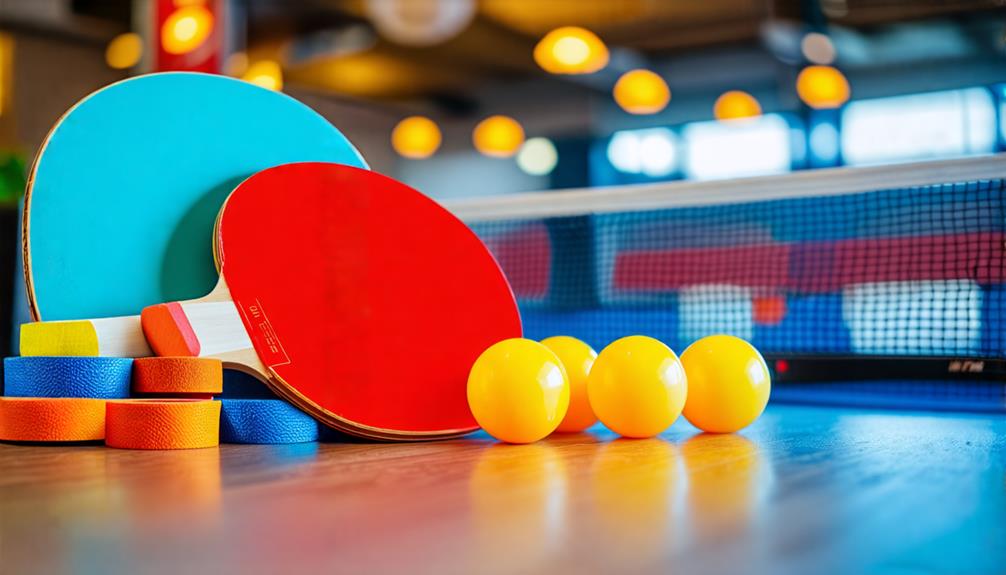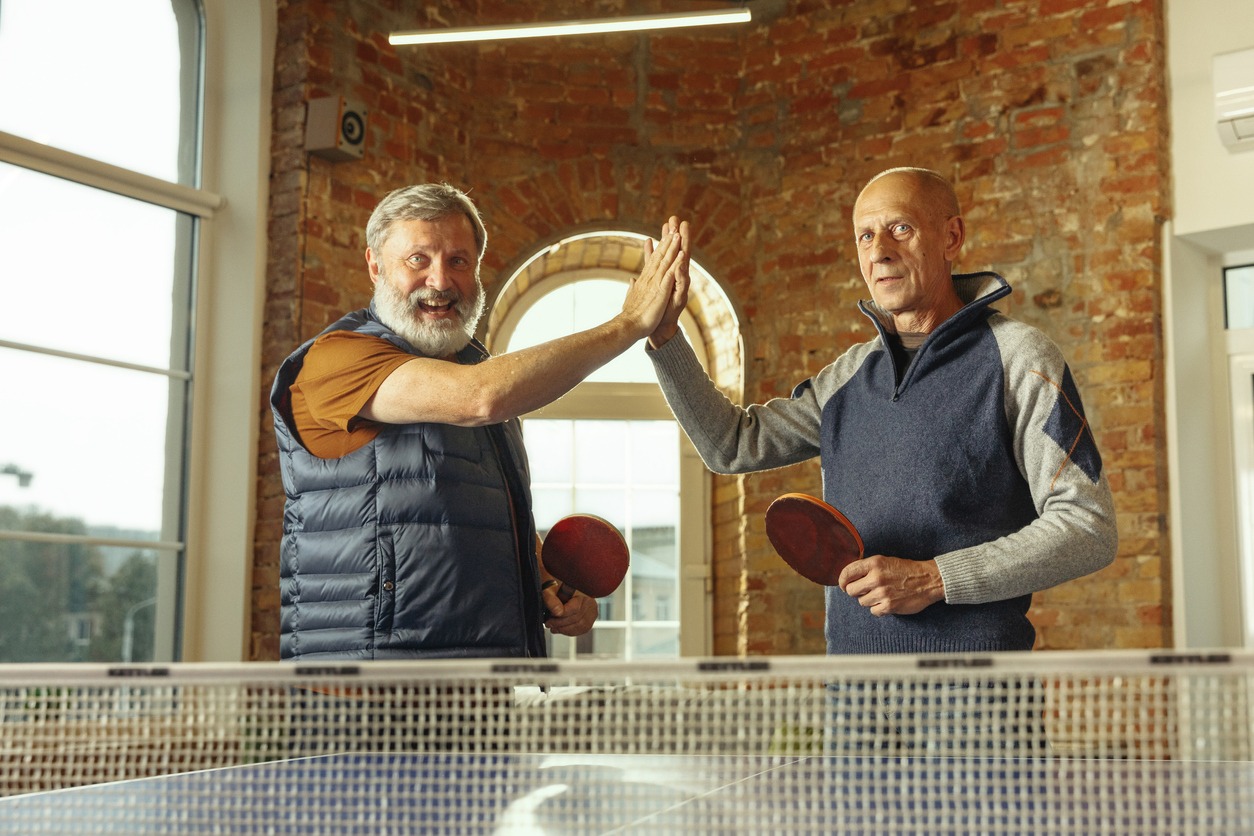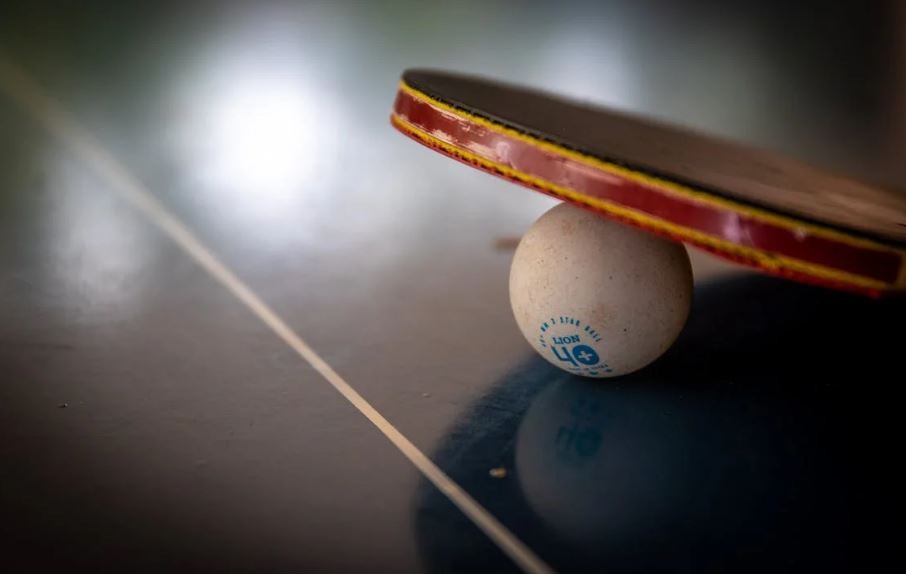Choosing the Right Ping Pong Table for Your Game Room
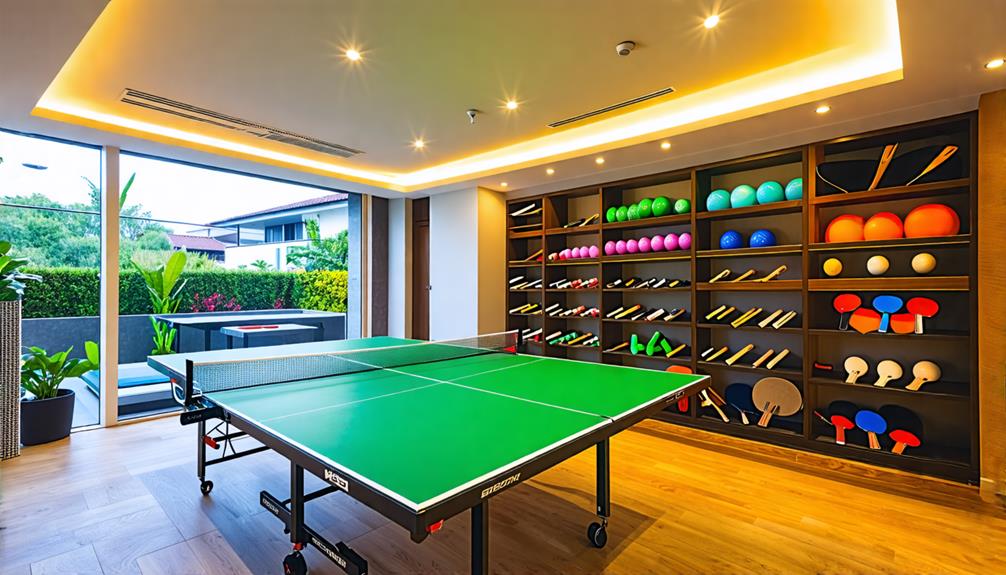
When selecting a ping pong table for your game room, consider several key factors that can significantly impact your playing experience. Think about the table's size, material, and your skill level. A standard 9-foot table is ideal for serious matches, but if space is limited, smaller options are available. Investigate features that cater to both casual and competitive play. By weighing these options, you may discover surprising choices that could enhance your game.
Table Types and Sizes
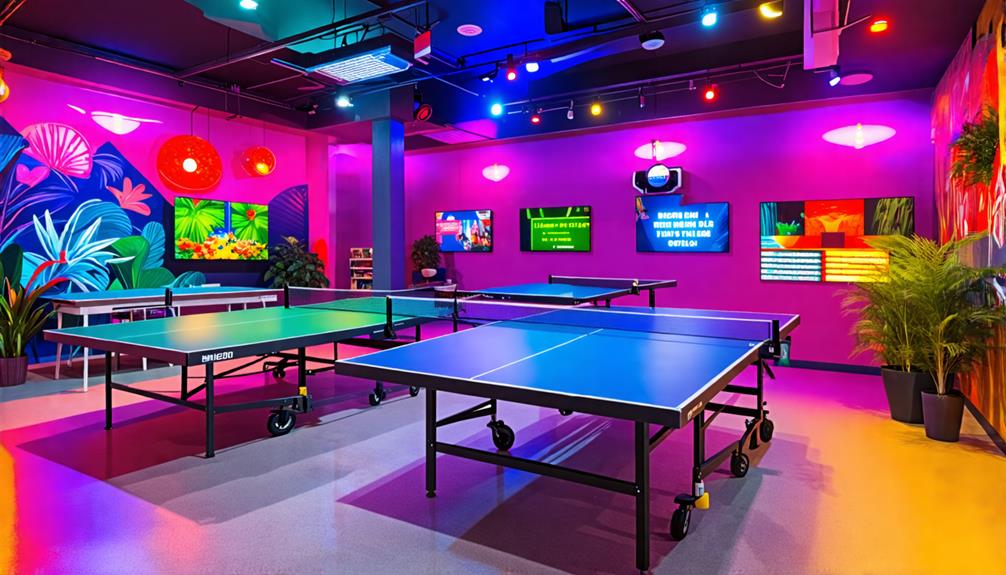
When choosing a ping pong table, you'll find various types and sizes catering to different spaces and playing styles. Standard table sizes measure 9 feet long, 5 feet wide, and 2.5 feet tall, making them ideal for competitive play. For recreational use, consider smaller table sizes ranging from 5 to 8 feet, which fit well in apartments or game rooms. For even tighter spaces, mini tables less than 5 feet long are perfect for children's rooms or home offices, offering a fun way to play without taking up much room.
When deciding between indoor and outdoor tables, note that indoor tables are generally lighter and more affordable. In contrast, outdoor tables are built with weather-resistant materials, allowing you to enjoy a game regardless of the elements. If you want flexibility, conversion tops can transform existing surfaces into a ping pong playing area, giving you the option to play without committing to a full table. Each table type and size offers unique benefits, so consider your space and playing style before making a choice.
Thickness and Material Considerations
Choosing the right thickness and material for your ping pong table is crucial, as it directly affects play quality and table longevity. For optimal bounce, select a table with a thickness of at least 19 mm. Tables with a 22 mm thickness are ideal for competitive play, while those under 15 mm, although more affordable, compromise on bounce quality.
Surface material is also pivotal. MDF (Medium-Density Fiberboard) is a popular choice for indoor tables due to its consistent bounce. For outdoor tables, aluminum is preferred for its weather resistance and durability. Higher quality materials like plywood or high-density MDF are less prone to warping, ensuring longevity with proper care.
While cost is an important factor, investing in a table with durable wheels and robust materials can save money in the long run. Prices generally range from $300 to $800 for thicker, well-constructed tables, while budget models can be found for $100 to $300. Ultimately, choosing based on thickness and material will enhance your playing experience and ensure your table lasts for years.
Essential Features and Accessories
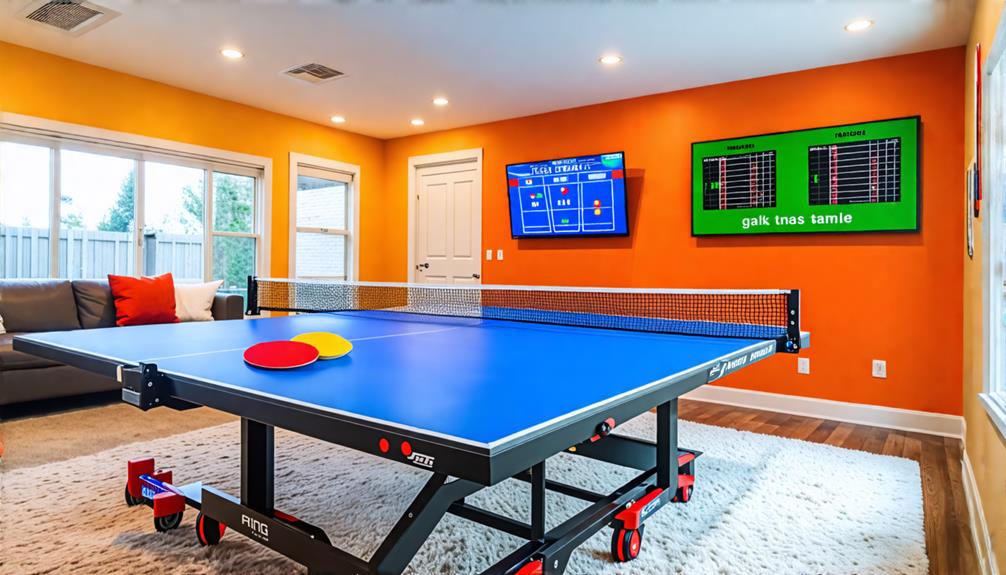
When selecting a ping pong table, prioritize features that enhance your playing experience. Opt for a foldable design for convenient storage and integrated compartments to keep paddles and balls organized. Additionally, consider essential accessories like adjustable nets and wheels for easy mobility, which can significantly improve your gameplay.
Table Design Considerations
A well-designed ping pong table incorporates essential features and accessories that significantly enhance your gameplay experience. When considering table design, focus on the following key aspects:
- Surface Thickness: Opt for tables with a surface thickness of at least 22 mm for optimal bounce and professional-level play.
- Foldable Design: This feature conserves space, making it easier to store the table in smaller game rooms or multi-use areas.
Ensure your table includes a net and post set with adjustable nets to maintain proper tension and height. Adjustable legs are also crucial for accommodating uneven surfaces, ensuring a level playing field. Integrated storage options for paddles and balls add convenience and enhance your overall playing experience. Prioritizing these design elements will set you up for countless enjoyable matches and practice sessions.
Recommended Accessories and Features
To enhance your ping pong experience, consider essential accessories and features that complement your table tennis setup. When selecting a table, look for a net and post set with adjustable height and tension to suit your playing style. A foldable design is particularly beneficial for those with limited space, making storage effortless.
Tables equipped with wheels are advantageous for mobility, but ensure these wheels have a locking mechanism for stability during intense play. Integrated storage options can be very convenient for keeping paddles and balls organized and within easy reach. For solo practice, choose a table with a playback feature that allows you to prop up one side, significantly aiding skill improvement. Additionally, invest in high-quality paddles and balls to complete your setup. By focusing on these key features and accessories, you'll create a game room that maximizes enjoyment and performance for all players.
Assessing Room Size and Placement
When selecting a location for your ping pong table, it's crucial to consider the room dimensions. Adequate clearance space around the table ensures smooth gameplay and minimizes the risk of accidents. Measure your area carefully to ensure the table fits comfortably without any obstructions.
Room Dimensions Consideration
Evaluating your room's dimensions is crucial for ensuring you have the right space to enjoy ping pong without restrictions. To create an ideal playing environment, consider the following:
- Minimum space: Aim for at least 19 feet in length and 11 feet in width.
- Clearance: Ensure a minimum of 3 feet on each side and 4-5 feet at each end for comfortable movement.
When assessing your room dimensions, consider the playing area in relation to your furniture and other items. Relocate any fragile items nearby to prevent damage during intense matches. Adequate space not only enhances the gaming experience but also ensures safe play without obstacles.
Clearance Space Requirements
Ensuring adequate clearance space around your ping pong table is crucial for an enjoyable and safe game. For optimal play, your room should be at least 19 feet long and 11 feet wide. This allows for a minimum of 3 feet of clearance on each side of the table and 4-5 feet at each end, facilitating comfortable movement and reducing the risk of accidents. Safety is also paramount; remove any fragile items from the playing area to protect your belongings and enhance the gameplay experience. Additionally, ensure the ceiling height is at least 10 feet to accommodate arm movements during play.
Budgeting for Your Table
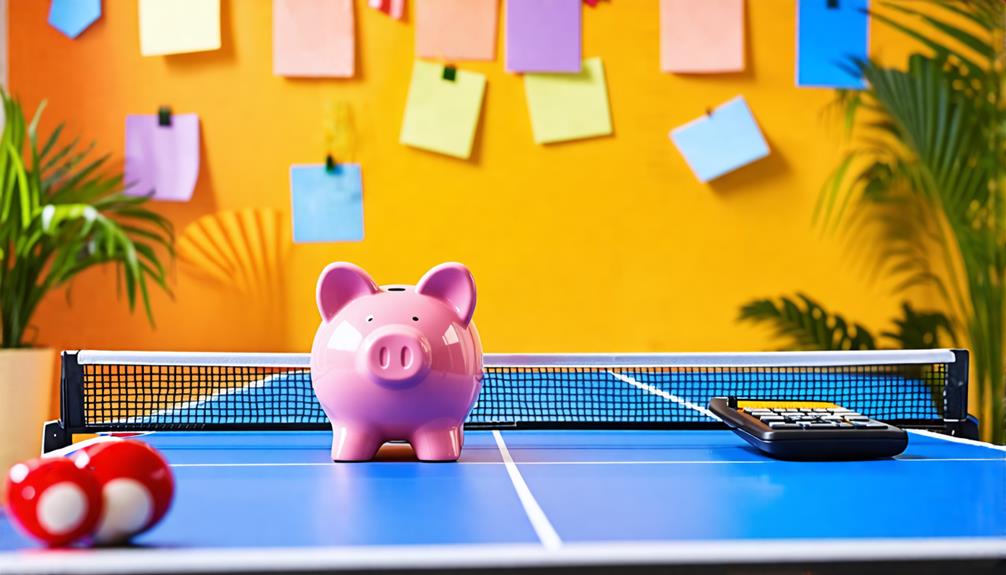
Establishing a budget for your ping pong table upfront helps you focus on options that truly fit your needs and financial situation. By defining your budget, you can narrow down choices and ensure you stay within your financial constraints.
Here's a quick overview of what to expect at different price points:
- Entry-level: Typically ranges from $100 to $300, ideal for casual players and families.
- Mid-range: Priced between $300 and $800, offering better durability and quality for beginner to intermediate players.
Keep an eye out for seasonal sales and discounts, as these can significantly reduce the cost of higher-quality options. By doing your research and staying aware of available promotions, you might find an excellent table that surpasses your expectations without straining your budget.
User Needs and Preferences
When selecting a ping pong table, consider the skill levels of all potential players to choose one that meets their needs. Additionally, evaluate the available space in your game room to ensure sufficient clearance for an optimal playing experience. Balancing these factors will help you make the most informed decision for your circumstances.
Skill Level Considerations
Choosing the right ping pong table requires considering the skill levels and preferences of all potential players. This ensures you make an informed decision that suits everyone's needs.
Key considerations include:
- Beginners: Entry-level tables, priced between $100 and $300, are ideal for casual play. They're durable and help newcomers learn the game's rules without a significant investment.
- Intermediate Players: Those with some experience should look for mid-range tables costing between $300 and $800. These tables offer enhanced durability and a better playing surface, facilitating skill development.
Always assess the ages and skill levels of all players to choose a table that balances durability and performance. The right table can significantly enhance your enjoyment of the game, regardless of skill level.
Space Availability Assessment
After evaluating skill levels, the next step is to assess the available space to ensure your ping pong table fits comfortably and allows for optimal gameplay. Begin by verifying that your game room can accommodate the standard dimensions of a ping pong table, which are 9 feet long and 5 feet wide. Additionally, you need a minimum clearance of 3 feet on each side and 4-5 feet at each end, totaling a required area of approximately 19 feet long and 11 feet wide.
Check the ceiling height as well; a minimum of 10 feet is recommended to prevent high shots from hitting the ceiling. Consider the table's weight and mobility too. If space is limited, foldable tables with wheels are ideal for easy storage, though heavier stationary tables generally offer better stability during play.
Indoor Vs Outdoor Tables
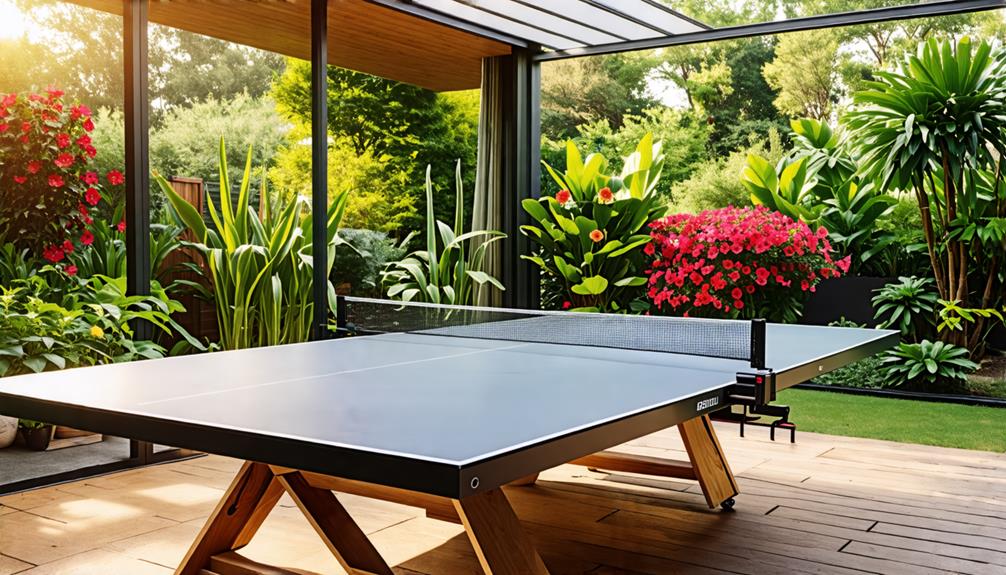
Understanding the differences between indoor and outdoor ping pong tables helps you make the right choice for your playing environment. Each type has unique features suited for specific conditions.
- Indoor tables are typically lightweight and affordable, ideal for recreational play in controlled spaces. They usually feature surface thicknesses between 15 mm and 25 mm, providing excellent bounce quality.
- Outdoor tables are constructed from durable, weather-resistant materials, ensuring they withstand various elements. They often incorporate quality materials with thicker surfaces, exceeding 22 mm in thickness, which reinforces their resilience against the elements.
While both types share the standard dimensions of 9 feet long and 5 feet wide, their differences in construction and material significantly affect performance and durability. When it comes to maintenance, indoor tables require less upkeep and fit more easily into smaller spaces. Outdoor tables, however, offer the versatility of permanent placement in a backyard or patio. Ultimately, your decision should reflect your environment and how you plan to enjoy table tennis.
Evaluating Skill Levels
Knowing your skill level is key to selecting the right ping pong table that matches your playing style and needs. If you're a casual player, an entry-level table priced between $100 and $300 might be perfect for you. These tables, like the MyT 415 Max, offer durable construction and good bounce quality, making them suitable for beginners learning the game.
As you progress to intermediate skill levels, consider mid-range options priced between $300 and $800. Look for tables with a thickness of 16 to 19 mm; they provide balanced bounce quality and performance that suit your developing skills. For advanced players, professional tables are essential. These tables often meet ITTF standards and have a thickness of 22 mm or more, ensuring excellent bounce and stability for competitive play.
Maintenance and Care Tips
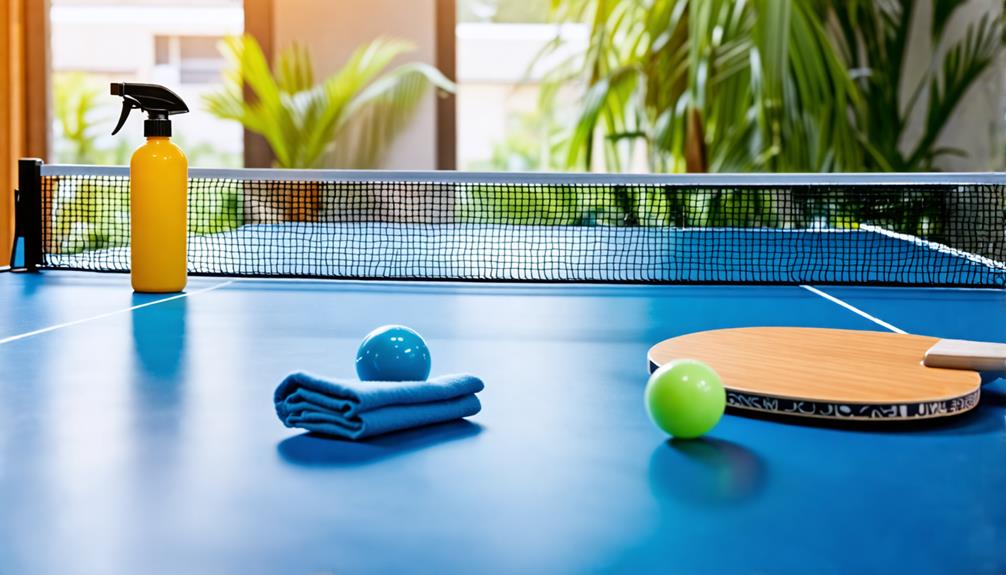
To keep your ping pong table in peak condition for years of enjoyable play, proper maintenance is essential. Here are some crucial tips:
- Regular Dusting: Use a soft, dry cloth to dust your table regularly. This helps maintain the playing surface and prevents buildup that can affect gameplay.
- Use a Fitted Cover: Always cover the table with a fitted cover when it's not in use. This protects it from dust, moisture, and potential scratches, thus reducing wear and tear.
Additionally, promptly wipe up any spills to avoid damaging the playing surface. Store your indoor table in a dry area with stable temperatures to prevent warping. Regularly check your net and accessories for tears, and keep them in a dry environment. Following these simple maintenance tips will keep your ping pong table in excellent shape, ready for countless matches ahead!
Recommended Products and Brands
When selecting a ping pong table, considering top products and brands tailored to your playing style and environment is essential.
- For serious players seeking competition-ready options, the JOOLA Tour 2500 is a stellar choice. This table measures 108 x 60 x 30 inches and weighs 249 lbs, offering excellent stability for intense matches.
- For outdoor use, the Cornilleau 700X Outdoor is highly recommended. Constructed with weather-resistant materials, it meets ITTF bounce standards and measures 108 x 60 x 31.2 inches. Additionally, the Cornilleau 510M Outdoor is ideal for a more permanent setup, featuring practical enhancements such as racket holders and ball dispensers.
- For a durable indoor table, the Stiga Expert VM is ITTF approved and requires no assembly, weighing 313 lbs—perfect for a game room.
Lastly, if aesthetics are important, the RS Barcelona You and Me - Black combines style and functionality, making it a standout centerpiece in any stylish home game room. These recommended products cater to diverse needs, ensuring you find the perfect fit for your ping pong experience.
Conclusion
Selecting the ideal ping pong table for your game room can significantly enhance your playing experience. To find the perfect match for your space and skill level, consider the type of table, dimensions, thickness, and essential features. Decide between an indoor or outdoor table based on your environment and needs. Ensure it aligns with your budget and prioritize quality care and maintenance to keep the table in excellent condition. Enjoy the game and cherish the moments spent with friends and family!
